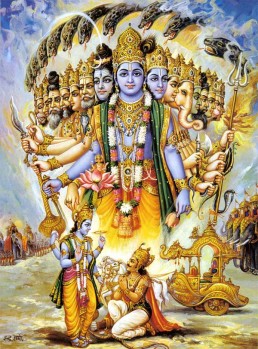Swami Chinmayananda
Swami Chinmayananda Commentary
The versatile genius of Vyasa has never left anything that he has touched without raising it to the most sublime heights of perfection. With unimaginable capacities for composing incomparable poetry, unique prose-diction, chaste descriptions, artistic, literary designs, original innovations both in thought and form — a brilliant philosopher, a man of consummate wisdom, a genius in worldly knowledge, at one time in the palace, at another time in the battle-field, at still another time in Badrinath, and again, among the silent snow peaks — strode the colossus, Sri Vyasa, as an embodiment of what is best in the Hindu tradition and in the Aryan culture. Such an all-round genius has not yet been reported ever to have been born, lived or achieved so much in the history of this globe, at any other time!
After Lord Krishna gave Arjuna a hint as to what he should expect and where he would gain the vision of the Cosmic-Man, etc., Vyasa introduces a small section in which Sanjaya reports to Dhritarashtra, the blind father of the wicked Kauravas.
The literary purpose served by this stanza is only to show to the readers that Krishna, according to his promise, had actually revealed his Cosmic-Form to Arjuna. But along with that, the deft mastery of the ancient writer of Mahabharata tries to paint for us the mental attitude and the inward sympathies of Sanjaya. We have stated earlier that Sanjaya is “OUR OWN SPECIAL CORRESPONDENT.” His sympathies are clearly with the Pandavas, the friends of the Lord. This tendency in Sanjaya is unquestionably revealed when he addressed his own master merely as “O King” (Rajan) while he uses the terms, (a) Mahayogeshwara … “the Great Lord of Yoga” and (b) Harih … “the one who maintains the champions of Truth by destroying the powers of falsehood,” to indicate Lord Krishna. The implied suggestions of these words point at a bloodless murder of the blind old King!
With Sanjaya’s words, the crowd of listeners and students of Geeta are shifted from the field of the battle to the palace of the battle-monger. This is perhaps necessary to remind the readers that the philosophy of the Geeta has an intimate practical application to life. Sanjaya informs Dhritarashtra that the Great Lord of Yoga showed to Arjuna his Supreme Ishwara-form. Sanjaya entertains a thin hope that, at least on hearing that the Lord of the Universe is on the side of his nephews, the blind King will foresee the sure defeat of his sons and, in his discrimination, will cry a halt to the impending disastrous war.
IN A ROUGH OUTLINE SANJAYA DESCRIBES THE LIST OF THINGS THAT WERE VISIBLE WITHIN THE FRAMEWORK OF THE DIVINE CHARIOTEER:
Adi Sankara Commentary
Rajan, O King, Dhrtarastra; uktva, having spoken evam, thus, in the manner stated above; tatah, thereafter; harih, Hari, Narayana; maha-yogeswarah, the great Master of Yoga-who is great (mahan) and also the master (isvara) of Yoga; darasyamasa showed; parthaya, to the son of Prtha; the paramam, supreme; aisvaram, divine; rupam, form, the Cosmic form:
The Bhagavad Gita with the commentary of Sri Sankaracharya – Translated by Alladi Mahadeva Sastry
Holy Geeta – Commentary by Swami Chinmayananda
The Bhagavad Gita by Eknath Easwaran – Best selling translation of the Bhagavad Gita
The Bhagavad Gita – Translation and Commentary by Swami Sivananda
Bhagavad Gita – Translation and Commentary by Bhaktivedanta Swami Prabupadha
Srimad Bhagavad Gita Chapter 11 – Verse 9 – 11.9 evamuktva tato – All Bhagavad Gita (Geeta) Verses in Sanskrit, English, Transliteration, Word Meaning, Translation, Audio, Shankara Bhashya, Adi Sankaracharya Commentary and Links to Videos by Swami Chinmayananda and others – 11-9

